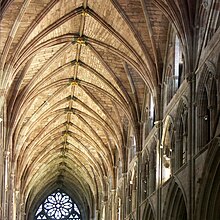| This article needs additional citations for verification. Please help improve this article by adding citations to reliable sources. Unsourced material may be challenged and removed. Find sources: "Ogive" – news · newspapers · books · scholar · JSTOR (May 2013) (Learn how and when to remove this message) |



An ogive (/ˈoʊdʒaɪv/ OH-jyve) is the roundly tapered end of a two- or three-dimensional object. Ogive curves and surfaces are used in engineering, architecture, woodworking, and ballistics.
Etymology
The French Orientalist Georges Séraphin Colin gives as the term's origin the Arabic al-ġubb (الجُبّ) 'cistern', pronounced al-ġibb (الجِبّ) in vernacular Iberian Arabic, through the Spanish aljibe or archaically algibe.
The earliest use of the word ogive is found in the 13th-century sketchbook of Villard de Honnecourt, from Picardy in northern France. The Oxford English Dictionary considers the French term's origin obscure; it might come from the Late Latin obviata, the feminine perfect passive participle of obviare, meaning the one who has met or encountered the other. However, Merriam-Webster's dictionary says it is from the "Middle English oggif stone comprising an arch, from Middle French augive, ogive diagonal arch".
Types and use in applied physical science and engineering
| This section does not cite any sources. Please help improve this section by adding citations to reliable sources. Unsourced material may be challenged and removed. (January 2020) (Learn how and when to remove this message) |
In ballistics or aerodynamics, an ogive is a pointed, curved surface mainly used to form the approximately streamlined nose of a bullet or other projectile, reducing air resistance or the drag of air. The French word ogive can be translated as "nose cone" or "warhead".
The traditional or secant ogive is a surface of revolution of the same curve that forms a Gothic arch; that is, a circular arc, of greater radius than the diameter of the cylindrical section ("shank"), is drawn from the edge of the shank until it intercepts the axis.
If this arc is drawn so that it meets the shank at zero angle (that is, the distance of the centre of the arc from the axis, plus the radius of the shank, equals the radius of the arc), then it is called a tangent or spitzer ogive. This is a very common ogive for high velocity (supersonic) rifle bullets.
The sharpness of this ogive is expressed by the ratio of its radius to the diameter of the cylinder; a value of one half being a hemispherical dome, and larger values being progressively more pointed. Values of 4 to 10 are commonly used in rifle bullets, with 6 being the most common.
Another common ogive for bullets is the elliptical ogive. This is a curve very similar to the spitzer ogive, except that the circular arc is replaced by an ellipse defined in such a way that it meets the axis at exactly 90°. This gives a somewhat rounded nose regardless of the sharpness ratio. An elliptical ogive is normally described in terms of the ratio of the length of the ogive to the diameter of the shank. A ratio of one half would be, once again, a hemisphere. Values close to 1 are common in practice. Elliptical ogives are mainly used in pistol bullets.
More complex ogives can be derived from minimum turbulence calculations rather than geometric forms, such as the von Kármán ogive used for supersonic missiles, aircraft and ordnance.
Architecture

One of the defining characteristics of Gothic architecture is the pointed arch.
History
Pointed arches may have originated as in the Sitamarhi caves in the 3rd century BCE. The free-standing temple of Trivikrama at Ter in Maharashtra (India) (dated to the Satavahana period of the 2nd century BCE to the 3rd century CE) also contains an ogive arch but it is constructed using corbel principles.
Excavations conducted by Archaeological Survey of India (ASI) at Kausambi revealed a palace with foundations from the 8th century BCE until the 2nd century CE, built in six phases. The last phase, dated to 1st–2nd century CE, includes an extensive structure which features four centered pointed arches which were used to span narrow passageways and segmental arches for wider areas. Pointed arches with load-bearing functions were also employed in Gandhara. A two pointed-arch vault-system was built inside the Bhitargaon temple (as noted by Alexander Cunningham) which is dated to the early Gupta period of the 4th–5th centuries CE. Pointed arches also appeared in Mahabodhi temple with relieving arches and vaults between the 6th and 7th centuries CE.
The 5th- or 6th-century CE Romano-Byzantine Karamagara Bridge in Cappadocia (in present-day Turkish Central Anatolia) features an early pointed arch as part of an apparent Romano-Greco-Syrian architectural tradition.
Several scholars see the pointed arch as first established as an architectonic principle in the Middle East in Islamic architecture during the Abbasid Caliphate in the middle of the 8th century CE. Pointed arches appeared in Christian Europe by the 11th century CE.
Debate
Some scholars have refused to accept an Indian origin of the pointed arch, including Hill (1993); some scholars have argued that pointed arches were used in the Near East in pre-Islamic architecture, but others have stated that these arches were, in fact, parabolic and not pointed arches.
Usage
Gothic architecture features ogives as the intersecting transverse ribs of arches which establish the surface of a Gothic vault. An ogive or ogival arch is a pointed, "Gothic" arch, drawn with compasses as outlined above, or with arcs of an ellipse as described. A very narrow, steeply pointed ogive arch is sometimes called a "lancet arch". The most common form is an equilateral arch, where the radius is the same as the width. In the later Flamboyant Gothic style, an "ogee arch", an arch with a pointed head, like S-shaped curves, became prevalent.
Glaciology
In glaciology, the term ogives refers to alternating bands of light and dark coloured ice that occur as a result of glaciers moving through an icefall.
See also
References
- Colin, Georges Séraphin (1937). "Origine arabe du mot français ogive". Romania. 63 (251): 377–381. doi:10.3406/roma.1937.3849.
- "Le Trésor de la Langue Française online". 2015-06-03.
- "Definition of Ogive". www.merriam-webster.com. Retrieved 2018-11-07.
- Gosh, A. (1964). Indian Archaeology: A review 1961-62. New Delhi: Archaeological survey of India. pp. 50–52.
- District Gazetteers Of The United Provinces Of Agra And Oudh Cawnpore Vol Xix. p. 190.
- ^ Le, Huu Phuoc (2010). Buddhist Architecture. Grafikol. ISBN 9780984404308.
-
Warren, John (1 September 1991). Grabar, Oleg (ed.). "Creswell's Use of the Theory of Dating by the Acuteness of the Pointed Arches in Early Muslim Architecture". Muqarnas: An Annual on Islamic Art and Architecture. 8: K. A. C. Creswell and his legacy. Leiden: E. J. Brill: 61-62. ISBN 90-04-09372-9. ISSN 0732-2992.
The enigmatic example which puzzled was Qasr Ibn Wardan, a building firmly dated to the reign of Justinian I, and he rightly concluded that the northern great arch still standing in the church there is slightly pointed . This he attributed to a local, i.e. Syrian, influence and therefore concluded firmly that Syria was the home of the invention which was later to suffuse so much of the architecture of western Europe. Had he looked more widely in the Byzantine Empire he could have adduced other evidence of the priority of the Greeks.: for instance the Karamagara Bridge which spanned the River Murat near Elazig in Asia Minor, the slight but certain example of the apse arch of St. Apollinaire in Classe in Ravenna, and the insecurely dated but powerful apse arch of St. Irene in Constantinople, as well as examples in Syria itself.
- Bloom, Jonathan M. (2017-05-15). Early Islamic Art and Architecture. Routledge. ISBN 9781351942584.
-
Darke, Diana (2020). "The Abbasid and Fatimid Caliphates (750-1258)". Stealing from the Saracens: How Islamic Architecture Shaped Europe. London: Oxford University Press. p. 208. ISBN 9781787383050. Retrieved 7 January 2024.
the first prominent monumental use of the pointed arch in Europe occurred at the third church of the Benedictine monastery at Cluny (Cluny III), built between 1088 and 1120 .
- Bailey, Julia; Bozdoğan, Sibel; Necipoğlu, Gülru (2007). History and Ideology: Architectural Heritage of the "Lands of Rum". Brill. ISBN 9789004163201.
- Warren, John (1991). "Creswell's Use of the Theory of Dating by the Acuteness of the Pointed Arches in Early Muslim Architecture". Muqarnas. Vol. 8. pp. 59–65.
- Memoirs of the Archaeological Survey of India. Director General, Archaeological Survey of India. 1926.
- Benn, Douglas I.; Evans, David J. A. (2014). Glaciers and Glaciation, 2nd edition. Routledge. p. 816. OCLC 879594461.
Further reading
- Verde, Tom, "The Point of the Arch", Aramco World, Volume 63, Number 3, 2012
